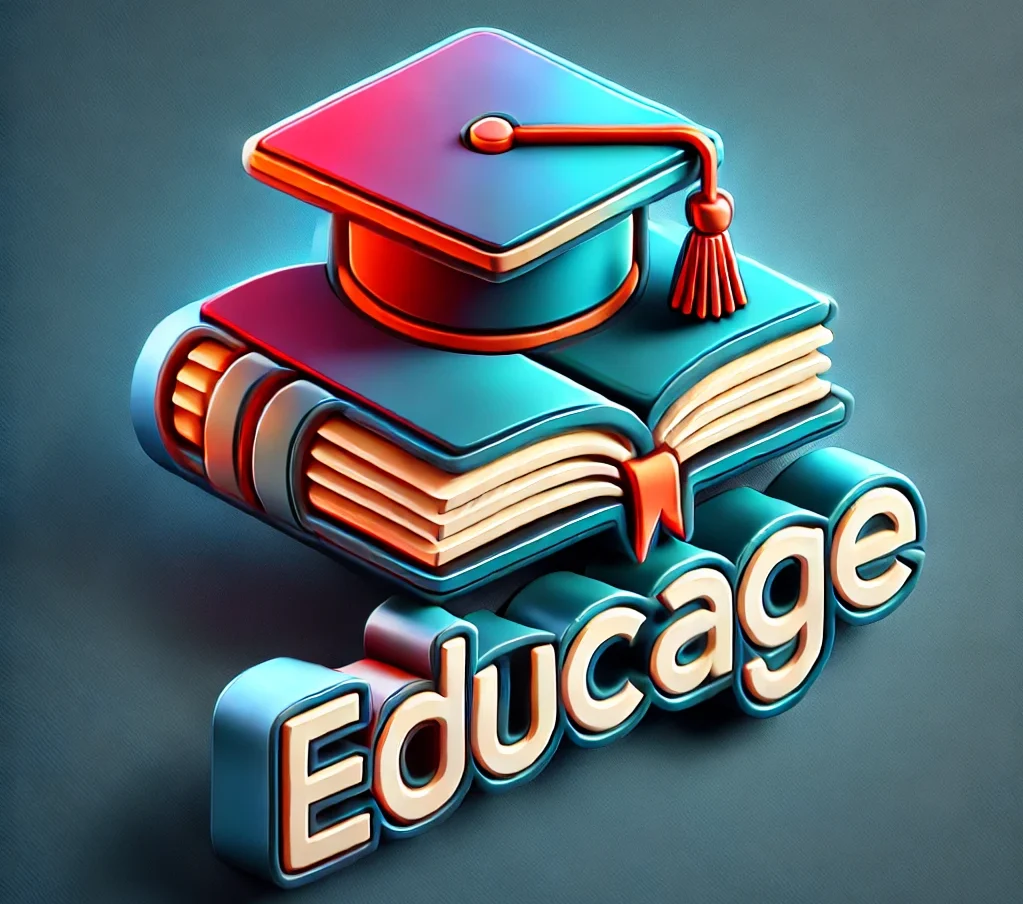“The most important thing to do if you find yourself in a hole is to stop digging.” This quote by Warren Buffett is very relevant today. Technology is changing our world, and educators must use AI-Driven Learning Tools. These tools are not just making learning better; they are changing classrooms everywhere.
With AI, schools are moving towards personalized learning. This means each student gets education that fits their needs.
AI uses voice and facial recognition to track how students and teachers interact. Imagine teachers getting feedback on how students feel and engage in real-time. This could lead to better teaching methods (source: PowerSchool Blog1). This technology makes classrooms more efficient and fair for all students.
AI can save teachers up to 13 hours a week by doing routine tasks. This lets teachers spend more time with students (source: PowerSchool Blog2). The AI education market is growing fast, expected to hit over $32 billion by 2030.
As you explore AI in education, remember the big changes happening. The future of learning combines technology and traditional methods. This creates a better place for both teachers and students to grow.
Key Takeaways
- AI-Driven Learning Tools are personalizing education.
- Real-time feedback encourages more effective teaching strategies.
- The global AI education market will exceed $32 billion by 2030.
- AI integration can save teachers significant time weekly.
- Machine learning technologies enhance classroom engagement and accessibility.
- AI tools can assist in identifying students at risk of falling behind.
The Rise of AI in Education
Today, AI is changing education in big ways. It’s making learning more personal and helping teachers work smarter. About 75% of schools say AI helps students learn better3.
This move to AI is key for making learning fit each student’s needs. It also makes teaching more efficient.
Current Statistics on AI Adoption in Classrooms
More schools are using AI than ever before. Even though 97% of leaders see AI’s value, only 35% have started using it4. Yet, 77% of teachers see AI’s benefits, but only 56% use it in class4.
Teachers are feeling the difference. They’ve seen a 42% drop in paperwork and a 25% boost in tailored learning4.
Overview of AI Technologies Utilized in Education
AI is all about making education better. It includes smart tutoring systems and tools that grade work automatically5. The e-learning market is expected to hit $460 billion by 2027, showing AI’s importance in education3.
AI-Driven Learning Tools
In today’s education, knowing about AI-driven tools is key. They change how we learn. These tools give content and learning experiences that fit each student’s needs. This makes learning more engaging and helps teachers teach better.
Definition and Purpose of AI-Driven Tools
AI-driven tools are many and help improve learning. They use machine learning for learning tools to automate tasks and understand how students do. This lets teachers focus on building relationships and meeting student needs, making learning better.
Types of AI-Driven Learning Tools in Use
Many AI-driven tools are used today. These include systems that adjust to each learner and platforms that track progress. Here’s a look at some tools and their ratings:
| Tool Name | Type | Rating |
|---|---|---|
| AI Question Paper Generator | Assessment Tool | 4.5 |
| Generative AI Assessments | Assessment Tool | 4.5 |
| Smart Sparrow | Adaptive Learning | 4.0 |
| AI Voice Assessments – Eklavvya | Assessment Tool | 4.5 |
| Coursera | Online Learning | 4.0 |
| Querium | Tutoring Platform | 4.0 |
| Woot Math | Math Education | 4.5 |
| GradeSlam | Tutoring Platform | 4.0 |
| TutorMe | Online Tutoring | 4.0 |
| OpenAI | Research Organization | 5.0 |
| Pearson AI | Educational Platform | 4.5 |
| Eklavvya | Evaluation Platform | 4.5 |
| Kaltura | Video Platform | 4.0 |
| Duolingo | Language Learning | 4.5 |
| Edmentum | Learning Platform | 4.0 |
AI tools are changing education for the better. They are becoming more popular in schools and online. To learn more, check out AI Learning Platforms. Knowing about these tools helps teachers choose the best ones for their classrooms.
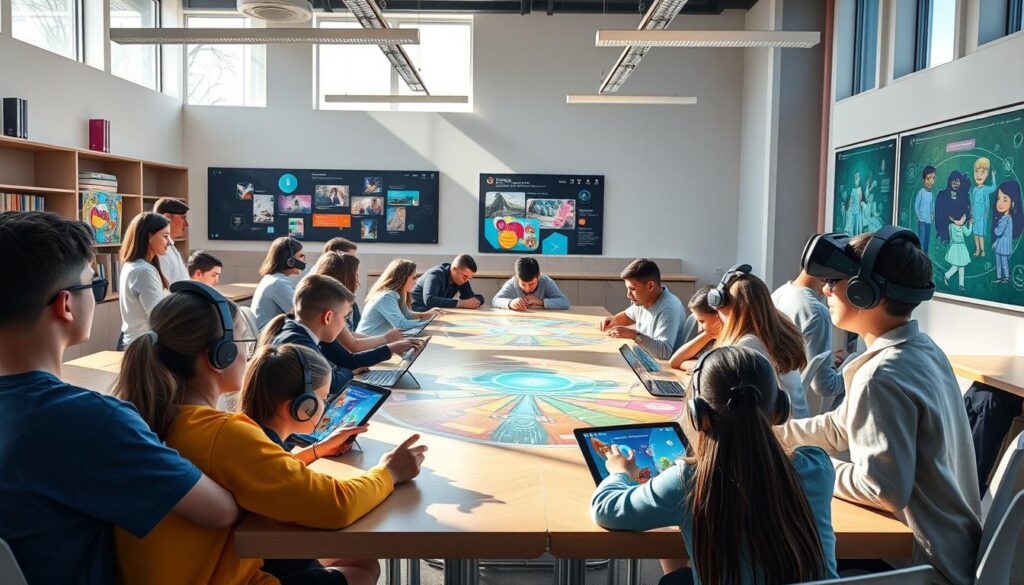
Personalized Learning Experiences
Today, personalized learning technology is changing how we teach. It lets teachers tailor lessons for each student’s unique needs. This makes learning more inclusive and effective, helping students do their best.
Teachers are moving from old ways of teaching to new ones. They now focus on guiding students, not just lecturing. Many teachers see big improvements in student success with these new methods6.
Adaptation of Content to Individual Learners
Personalized learning uses adaptive learning algorithms to adjust lessons for each student. This way, everyone can learn at their own speed. Studies show it makes students more engaged and motivated7.
Students feel more in control of their learning, which boosts their confidence. This approach helps them do well in school and makes learning fun7.
Improved Student Engagement through Personalization
Enhanced student engagement comes from learning that matches each student’s interests and strengths. AI tools help teachers make lessons more relevant and effective. Teachers see students more engaged and confident, leading to better grades67.
AI helps teachers save time by creating personalized learning plans. This leads to better student performance, showing the value of tailored learning6.
Intelligent Tutoring Systems
Intelligent tutoring systems (ITS) are changing education. They offer personalized learning experiences through tailored instruction. These systems use artificial intelligence (AI) to meet each learner’s unique needs, making learning more engaging and effective.
Features of Intelligent Tutoring Systems
ITS are equipped with AI features that help them meet student needs. They have a knowledge base, a student model, a pedagogical module, and a user interface. This setup allows for real-time feedback and interactive learning, fitting different learning styles and paces.
Since their start around 1970, these systems have grown a lot. They’ve moved from simple test projects to useful tools in schools8. Now, they focus on theory-based interfaces, showing their ongoing evolution9.
Impact on Student Learning and Self-Directed Learning
AI in ITS has a big impact on learning. It offers tailored instruction that boosts understanding and retention. Despite challenges, ITSs have the power to change education for the better9.
ITSs also support self-directed learning. This lets students learn at their own pace, boosting motivation and interest in their studies8.
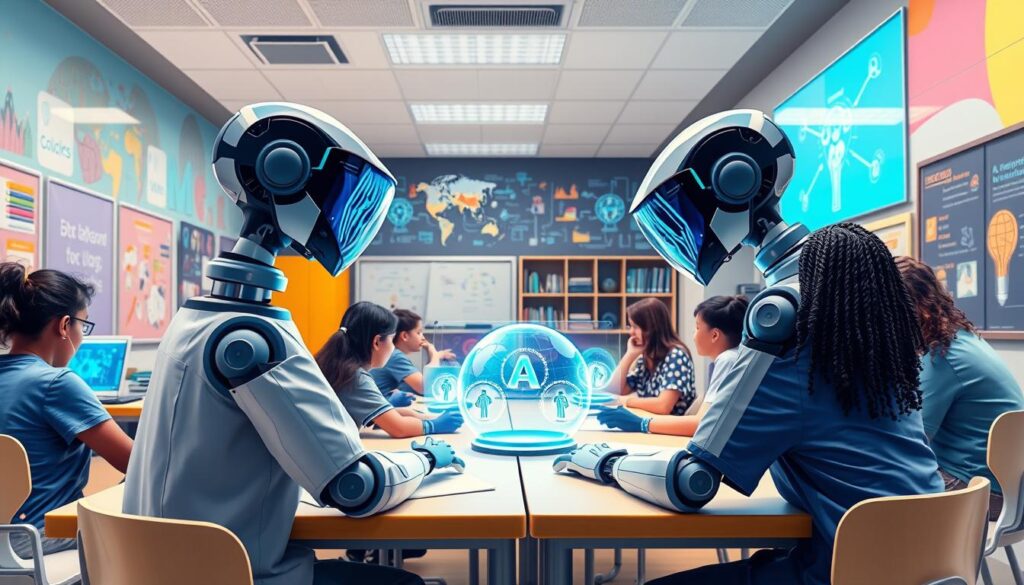
| Feature | Description |
|---|---|
| Personalization | Adapts instructional content to fit individual learning styles and paces. |
| Real-Time Feedback | Provides immediate responses to student actions, supporting timely corrections and guidance. |
| Self-Directed Learning | Encourages students to take charge of their learning by allowing them to manage their educational path. |
| Reduced Teacher Workload | Automates assessment processes and provides support, allowing teachers to focus on more complex educational tasks. |
| Advanced Technology | Utilizes technologies such as Natural Language Processing (NLP) for enhancing student interactions. |
Adaptive Learning Algorithms
Adaptive learning algorithms change how we learn by using data to adjust lessons for each student. This makes adaptive learning software better at meeting individual needs. It boosts student engagement and results.
In recent years, schools using these methods have seen a 23% increase in student success10. These algorithms create a more personalized learning space. This benefits both students and teachers.
How Adaptive Learning Works
Adaptive learning adjusts lessons in real-time to match each student’s skill level. Companies like Knewton, CogBooks, and Pearson Interactive Labs have seen great success. Knewton has partnered with 23 education companies and schools in seven years11.
CogBooks provides one-on-one support to help students improve. Pearson’s hybrid-lab setting adds real-life learning experiences11.
Case Studies on Adaptive Learning Success
Many case studies in adaptive learning show its benefits. A study by the International Society for Technology in Education found a 37% increase in student engagement10. Harvard Business and other schools have also seen success with AI in education10.
These results show how adaptive learning can greatly improve education.
Data-Driven Educational Tools
The world of education is always changing thanks to new technology. Data-driven tools are key in this shift. They use learning analytics for teachers to understand how students learn and perform. This helps teachers adjust their teaching to meet student needs better.
Using Analytics to Improve Teaching Strategies
In the last five years, AI tools have become more common in schools. They help teachers use data-driven educational tools to improve their teaching. AI helps spot patterns in student behavior, allowing teachers to make better plans and improve learning outcomes12.
With personalized analytics, teachers can make students more engaged and happy. This leads to better grades for students13.
Predictive Analytics for Student Performance
Predictive student analytics helps teachers see which students might struggle. AI looks at lots of data to predict who might drop out, so teachers can help them early13. Tools like Gradescope and Chat-GPT give quick feedback, making students more interested and motivated12.
Adaptive learning is becoming more common. It promises to make students stay in school longer and do better. This means a brighter future for education for you and your students14.
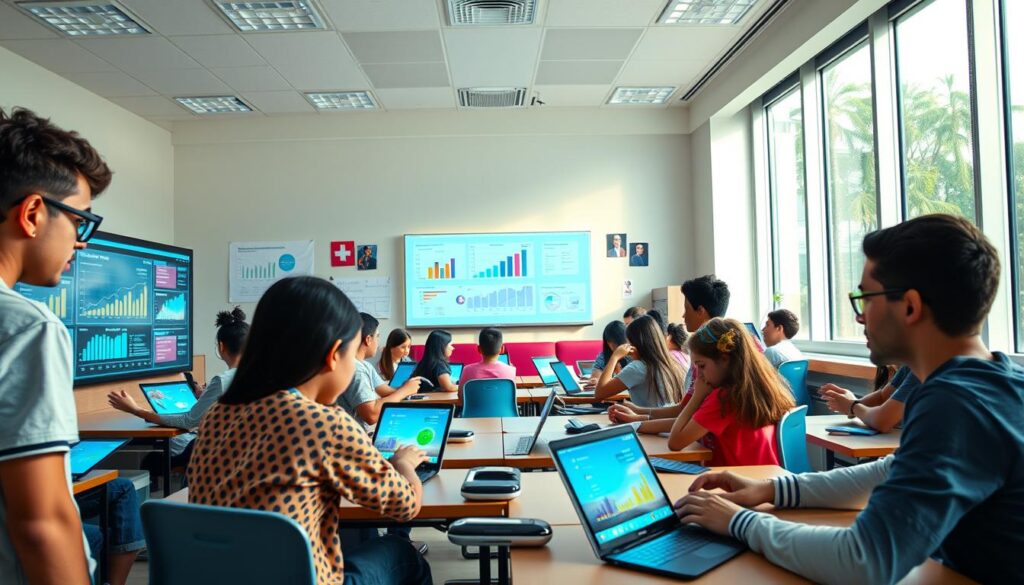
AI in Assessment and Grading
AI grading tools are changing how we grade in schools today. They make grading faster and more consistent. This helps solve problems like subjective grading and not enough time.
Automation of Grading Processes
Teachers are using AI to give quick feedback, especially in big classes. This lets them spend more time helping students one-on-one. For example, an intro finance course uses AI to grade, freeing up teachers for more personal help15.
AI is also good at checking writing, looking at grammar and how well ideas are connected. This way, teachers can focus on deeper feedback, like how well arguments are supported15.
Consistency and Speed in Evaluations
AI grading brings fairness and speed to grading. It works well in subjects that need deep thinking and creativity. But, we need to watch out for AI’s biases and how it handles subjective topics15.
The need for AI in schools is growing fast. It’s expected to reach $1.82 billion in 2021 and keep growing16. Teachers should use AI responsibly, protecting data and being open about how it grades. This way, all students can get a fair chance to learn from these new tools15.
Accessibility and Inclusion in Education
Ensuring all students can fully participate in learning is key. Assistive technologies are making schools more inclusive. AI helps by offering innovations for different learners.
These tools support students with disabilities and help all students communicate better. They make language translation in classrooms possible.
Assistive AI Technologies for Diverse Learners
Assistive AI technologies are vital for equal access to education. For example, speech recognition lets students with mobility issues control devices with their voice. Text-to-speech software helps those with visual impairments by turning text into sound17.
AI also makes learning personal by adapting to each student’s needs and learning style18. Yet, only about 7 percent of assistive technology users feel their community is well-represented in AI development19.
Real-Time Language Translation Features
Real-time language translation is changing classrooms for the better. It helps non-native speakers communicate better. AI provides live translations, letting students fully engage in their learning17.
Microsoft has equipped PCs with tools for live translation in almost every language. This shows how these technologies can bridge understanding gaps19. Real-time translation and transcription help all students, no matter their language background, to succeed18.
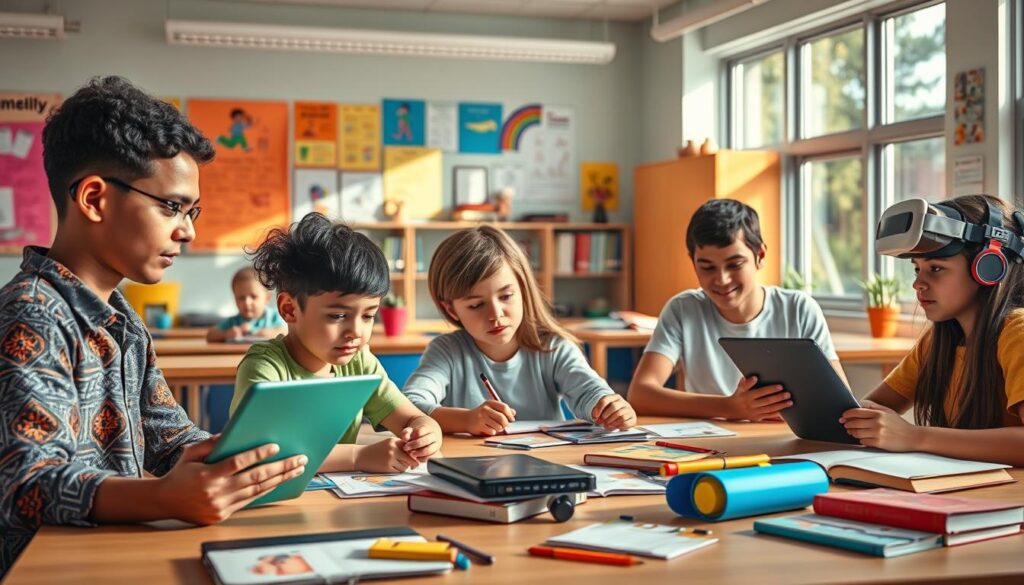
Challenges of Integrating AI in Classrooms
As schools start using AI, they face big challenges. One big worry is data privacy in education. Schools need to make sure they keep student info safe from hackers and misuse. Almost half of students have tried AI writing tools, but only 22% feel their teachers really get them20.
This gap can make students worry about sharing personal info. They might fear their data could be used in bad ways21.
Data Privacy and Security Concerns
AI use is growing fast, and keeping student data safe is key. Schools need strong security to protect student info. Teachers want to build trust and be open with students21.
But, collecting and storing data can be risky. Schools must follow strict privacy rules to keep students safe. Teachers worry about cheating and plagiarism with AI in class20.
Addressing Bias in AI Systems
Another big issue is bias in AI algorithms. These algorithms can unfairly affect students who don’t speak English well. This can lead to wrong judgments and misunderstandings2022.
Schools using AI should focus on fairness and transparency. This way, all students can learn well without bias. Teachers know that using AI wisely is key to good learning22.
Innovative Teaching Tools Enhanced by AI
The world of education is changing fast. New teaching tools are making learning more exciting. VR and AR in education bring students into immersive worlds. This makes learning fun and personal for each student.
Virtual and Augmented Reality in the Classroom
Virtual reality (VR) lets students explore real-life scenarios in a virtual space. Tools like Google Expeditions take them on virtual field trips. Augmented reality (AR) adds digital layers to the real world, making learning more interactive.
For example, MERGE Cube lets students learn by touch. This hands-on approach boosts their understanding.
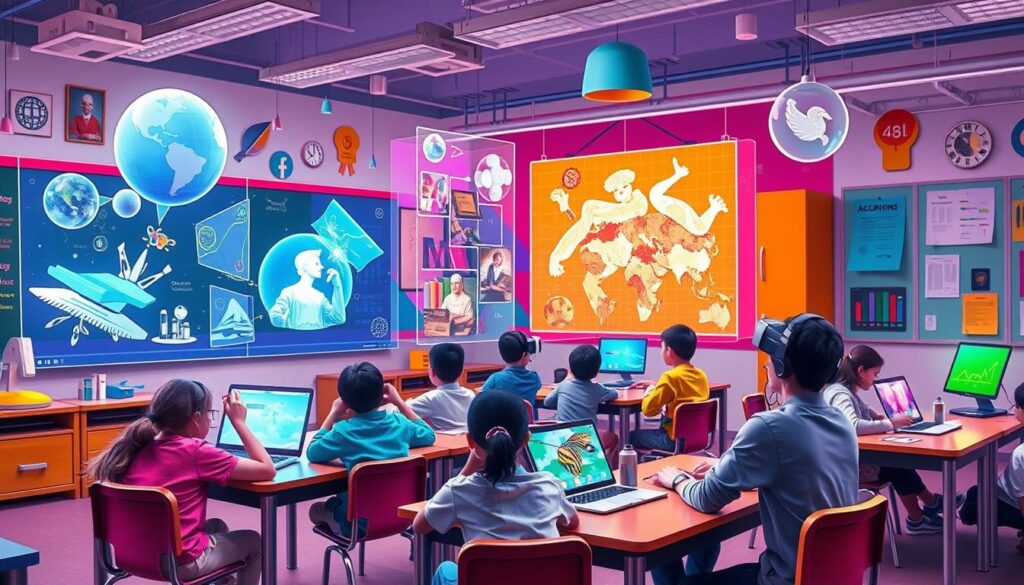
Gamification and Student Engagement
Gamification in learning makes school fun. It turns lessons into games, making students want to learn more. Kahoot! and Quizizz make learning a competition, while Classcraft turns classroom rules into a game.
AI-driven interactive learning platforms mix fun with learning. They help students dive deep into their studies23.
As schools use these tools, it’s key to see how they improve learning. AI helps personalize education for everyone. It meets different learning needs without losing quality2425.
Collaboration Between Educators and AI Developers
Working together, educators and AI developers are changing how we learn. They create solutions that fit the needs of today’s classrooms. For example, the U.S. Department of Education has new rules for AI in schools called “Designing for Education with Artificial Intelligence”26.
This new approach makes sure AI tools are good for all students. It focuses on helping students who learn differently and those who speak many languages26.
Case Studies of Successful Collaborations
At Crosstown High in Memphis, Tennessee, teachers and tech companies teamed up. They made learning fun and real through projects26. In Santa Ana, California, Círculos used AI to help students in Advanced Placement classes who speak many languages26.
These stories show how teamwork can make learning better for everyone.
The Role of Policy Makers in AI Integration
Policy makers help make AI a part of education by creating good rules27. The Chan Zuckerberg Initiative (CZI) has made tools for AI in schools. They make sure AI fits with what we know about learning27.
CZI also has a board of experts. They help make sure AI is used wisely in schools27.
The Future of AI in Classroom Education
Education is changing fast with AI leading the way. It’s making teaching more personal and effective. New tech will help create learning spaces that fit each student’s needs. This tech will make classrooms better for both teachers and students.
Emerging Trends and Technologies
AI is becoming common in schools, from K-12 to college28. It offers one-on-one tutoring that helps students learn and overcome challenges28. With AI, AR, and VR, learning will become more interactive and hands-on29.
Preparing for a Tech-Driven Learning Environment
Teachers need to keep up with new tech to use it well. AI helps with tasks like grading, freeing up time for teaching28. It also helps spot students who need extra help early on28. AI tailors learning to each student’s needs, making education more effective29.
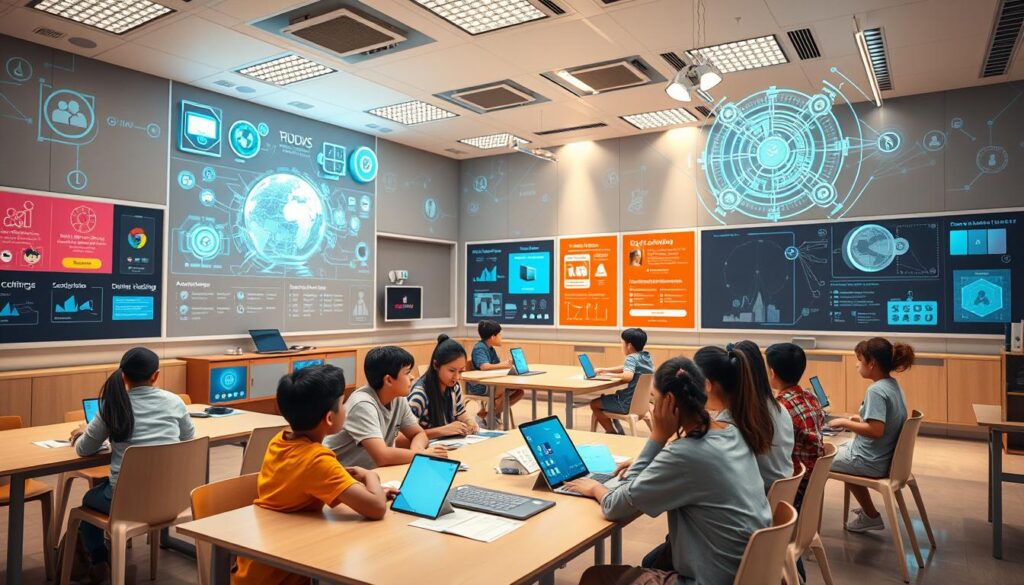
The future of AI in education looks promising. It makes learning fun and interactive, with feedback from smart classrooms30. Teachers will use AI to improve lessons, helping all students succeed30.
Conclusion
AI-driven learning tools are changing education in big ways. They make learning personal and fun, helping teachers do their best work. These tools analyze how students learn and what they like, making lessons better and more memorable3132.
But, AI also brings up big questions about privacy and fairness. It’s important to make sure everyone has access and that we don’t lose the human touch in learning. Teachers need to find a good balance between using AI and keeping learning real33.
The future of AI in schools looks bright. It will make learning more engaging and fair for everyone. Schools will need to keep learning and adapting to get the most out of AI, making education better for all3132.
FAQ
What are AI-driven learning tools?
How do AI technologies benefit students in the classroom?
What are intelligent tutoring systems and how do they work?
How do adaptive learning algorithms function in educational settings?
What role do data-driven educational tools play in teaching?
How does AI improve assessment and grading processes?
What are some challenges associated with integrating AI in education?
Can you explain the impact of innovative teaching tools enhanced by AI?
What is the importance of collaboration between educators and AI developers?
What does the future hold for AI in education?
Source Links
- https://digitalpromise.org/2024/07/03/how-ai-detects-student-engagement-to-transform-classrooms/
- https://www.viewsonic.com/library/education/using-ai-in-the-classroom-5-ways-to-transform-learning-teaching/
- https://www.forbes.com/councils/forbesbusinesscouncil/2024/02/13/the-rise-of-ai-enhanced-learning-education-for-the-digital-age/
- https://edtechmagazine.com/k12/article/2024/09/ai-education-2024-educators-express-mixed-feelings-technologys-future-perfcon
- https://onlineprograms.education.uiowa.edu/blog/role-of-ai-in-modern-education
- https://www.ednc.org/educators-journey-personalized-learning-artificial-intelligence-ai-integration/
- https://hyperspace.mv/future-of-personalized-education/
- https://slejournal.springeropen.com/articles/10.1186/s40561-023-00260-y
- https://www.princetonreview.com/ai-education/intelligent-tutoring-systems
- https://www.softwebsolutions.com/resources/ai-driven-adaptive-learning.html
- https://training.safetyculture.com/blog/adaptive-learning-platforms/
- https://www.iu.org/blog/ai-and-education/best-ai-tools-for-students/
- https://svitla.com/blog/leveraging-ai-in-education-exploring-big-data-and-related-applications/
- https://www.edutopia.org/article/7-ai-tools-that-help-teachers-work-more-efficiently/
- https://mitsloanedtech.mit.edu/2024/05/09/ai-assisted-grading-a-magic-wand-or-a-pandoras-box/
- https://www.leewayhertz.com/ai-use-cases-in-education/
- https://www.fxmweb.com/insights/ai-in-education-enhancing-accessibility-and-inclusivity-for-individuals-with-disabilities.html
- https://www.orcam.com/en-us/blog/practical-applications-ai-in-education-accessibility?srsltid=AfmBOoreQtqjazD-BIh8cfWcgTTuAO9qOiabYD6_YJ9H-v-YEZ4tgMMx
- https://er.educause.edu/articles/2024/9/the-impact-of-ai-in-advancing-accessibility-for-learners-with-disabilities
- https://education.illinois.edu/about/news-events/news/article/2024/10/24/ai-in-schools–pros-and-cons
- https://vasscompany.com/en/insights/blogs-articles/ai-education/
- https://www.higher-education-marketing.com/blog/limitations-of-ai-5-challenges-for-schools-to-consider-with-ai-education-marketing
- https://onlinedegrees.sandiego.edu/artificial-intelligence-education/
- https://www.masterycoding.com/blog/top-7-ai-tools-for-educators
- https://www.frontiersin.org/journals/artificial-intelligence/articles/10.3389/frai.2023.1255089/full
- https://www.the74million.org/article/artificial-intelligence-and-schools-when-tech-makers-and-educators-collaborate-ai-doesnt-have-to-be-scary/
- https://chanzuckerberg.com/newsroom/ai-developer-tools-for-education-launch/
- https://www.engageli.com/blog/artificial-intelligence-and-the-future-of-teaching-and-learning
- https://elearningindustry.com/predicting-the-future-of-ai-in-education-and-training
- https://autogpt.net/the-future-of-ai-in-education-revolutionizing-learning-for-the-next-generation/
- https://www.eschoolnews.com/digital-learning/2024/02/05/what-is-the-conclusion-of-artificial-intelligence-in-education/
- https://jeromejoseph.com/exploring-ai-driven-lessons-a-new-era-of-learning/
- https://codingweek.org/the-benefits-and-challenges-ai-poses-to-education/
